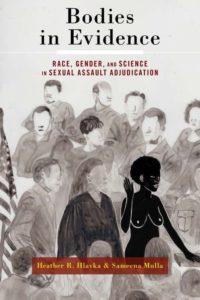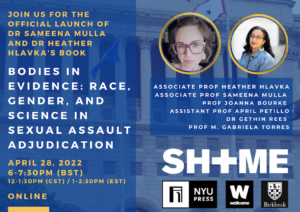Bodies in Evidence: Race, Gender, and Science in Sexual Assault Adjudication
By Heather Hlavka and Sameena Mulla and reviewed by SHaME’s Joanna Bourke

For victims of sexual assault, court proceedings are distressing. Hostile counsel, sceptical jurors, and hardened policemen are only three of the barriers to justice. Victims are also confronted by the burden of having to comport themselves according to a ‘rape script’, account for the paucity of medical or forensic evidence, and deal with the objectifying rituals of court procedures. While courts insist on corroboration in order to establish a victim’s credibility, the fact that defendants and victims usually share social worlds renders this extremely difficult.
In Bodies of Evidence: Race, Gender, and Science in Sexual Assault Adjudication, Heather R. Hlavka and Sameena Mulla focus their astute ethnographic eyes on the historical and cultural narratives that have created such problems. While their research centres on the city of Milwaukee (the largest city in the U.S. state of Wisconsin), their analysis is a damning indictment of legal practices and norms elsewhere. They not only build on their previous scholarship – most notable Mulla’s 2014 book, The Violence of Care: Rape Victims, Forensic Nurses, and Sexual Assault Intervention – but also on work by distinguished scholars such as Deborah Baskin, Rose Corrigan, Janice Du Mont, Deborah Parnis, Andrea Quinlan, Gethin Rees, and Ira Sommers. Sensitive to the ethical implications of reproducing spectacles of suffering in their book, they focus less on the rape itself and more on the harmful effects of legal processes, including those involving attorneys, the police, and medical professionals.
Part of the power of Hlavka and Mulla’s book lies in the way they expose deeply embedded assumptions about sexual assault. Victims as well as defendants and witnesses are – literally – ‘processed’ by legal systems. This involves the subtle uses of language, narrative-expectations, and courtroom rituals. Repeatedly, though, vicious racist, classist, and gendered tropes emerge.
As consummate ethnographers, Hlavka and Mulla lead readers through the everyday routines of the court, broadly following the chronology of a sexual assault trial. They start with the selection of the jury, before turning to the voices of victim-witnesses, statements by the police, and the expert testimony of medico-legal experts such as Sexual Assault Nurse Examiners (SANEs) and forensic scientists. Before concluding, they unpick the rhetoric of defendants when attempting to position themselves as ‘good men and fathers’. Although each chapter forms a coherent whole, this book is most effective if read from start to finish. The cumulative effect is devastating.
Hlavka and Mulla start by observing that very few instances of sexual assault actually make it to court. A tiny proportion of abused women report their assault to the authorities and, when they do, the evidential bar is set so high that only the most extreme cases are considered sufficiently ‘credible’ to warrant legal intervention.
Furthermore, even before the trial begins, numerous hurdles to a fair hearing are erected. The selection of jurors is inherently biased against victims. Jurors are predominantly white; victims and defendants, Black and Latino/a. Racist tropes appear time and again, including the assumption that Black girls and women are over-sexualised. Attorneys use racially coded language to suggest to jurors that women of colour are sexually deviant. Black defendants are also coded ‘promiscuous’ and, if they are fathers, assumed to be absentee ones.
Hlavka and Mulla reveal the extent to which legal beliefs about sexual assault are distorted. In order to be seen as credible, victims of sexual assault are required to comport themselves in very specific (and atypical) ways. Adult victims have to perform ‘trauma’, while simultaneously presenting themselves as passive and innocent. These performances are highly racialised, classed, and gendered. They also take place in open courts, filled not only with members of the victim’s family and close community, but also with strangers and sometimes vocal supporters of the defendant. Hlavka and Mulla describe one trial of a white policeman accused of assaulting and carrying out illegal body cavity searches of Black men, at which fellow-policemen stood in uniform in the public seats, creating a ‘blue wall’ of solidarity for their colleague. In the unlikely event of a conviction of a policeman, such defendants are presented as single ‘bad apples’, while the convictions of minoritised defendants are blamed on Black or Latino ‘cultures’.
The voices of victims are also refracted through legal narratives that distort their experiences. Indeed, the ‘distraught femininized subject’ is assumed to be incapable of speaking the ‘unspeakable’ realities of abuse without ‘judicial assistance’. The systemic inequalities and therefore vulnerabilities that pervade the lives of many victims (and result, for example, in them walking the streets at night) are decontextualized: defense attorneys suggest to jurors that victims have ‘chosen’ to place themselves at risk. They are blamed for poor decision-making or other personal failures.
The most insightful aspects of Hlavka and Mulla’s analysis involve their deconstruction of the testimony of police, medical, and forensic witnesses. For example, the testimonies of police witnesses are generally assumed by the court to be reliable, even though they are allowed huge discretion about what details of the assault they deem significant enough to jot down in their notebooks.
Police witnesses appear on the stand dressed in hyper-masculine uniforms, conveying their authority in all matters relating to crime. In contrast, Sexual Assault Nurse Examiners (SANEs) give evidence dressed in neat civilian clothes, not their scrubs. This creates the impression to jurors that SANEs belong to a feminised profession that might be biased in favour of victims. The medical and scientific expertise presented by SANEs are turned into legal artefacts. Nurse examiners strive to focus on the forensic evidence and injuries. They carefully tailor their remarks to maintain a balance between their healing role and their role as independent medical professionals. While the forensic examination is widely seen as a ‘trial by ordeal’ (as Rose Corrigan put it in her 2013 book Up Against a Wall: Rape Reform and the Failure of Success in the sense that by merely by agreeing to undergo this painful examination, victims were signalling their truthfulness), SANEs downplay the invasiveness of the procedures. Indeed, much of the intellectual labour of SANE personnel involves explaining to jurors the absence of evidence, due to the ‘resilience’ of female genital anatomy.
Finally, Bodies in Evidence is a scathing indictment of the failures of ‘justice’ systems for victims of sexual assault. The book convincingly show the myriad ways that the courtroom becomes a ‘site of risk not only for defendants but also for participating victims and witnesses’. For racialised victims, barriers to justice are formidable. But Hlavka and Mulla are equally clear about the need to reject carceral impulses. Siding with prison abolitionists, they make a strong argument that the solution to the problem of sexual violence is not the even greater imprisonment of Black and brown men. They end with a rallying cry. Abolitionists, they tell readers, ‘invite us to build a feminist future that replaces carceral solutions with new systems of accountability that centre community, healing, and repair’. Hlavka and Mulla invite their readers ‘to build this world with us’.
Sameena Mulla is Associate Professor of Women’s, Gender and Sexuality Studies at Emory University in Atlanta, GA. She is the author of The Violence of Care: Rape Victims, Forensic Nurses and Sexual Assault Intervention, for which she was awarded the Margaret Mead Award by the American Anthropological Association and the Society for Applied Anthropology.
Heather R. Hlavka is Associate Professor of Criminology and Law Studies in the Department of Social and Cultural Sciences at Marquette University in Milwaukee, WI. Her work appears in Gender & Society, Law & Society Review, Violence Against Women, Law and Social Inquiry, and Journal of Child Sexual Abuse.

Please join SHaME for its online launch of ‘Bodies in Evidence: Race, Gender, and Science in Sexual Assault Adjudication’ on Thursday 28th April, between 18-19.30 BST, and get 30% off and free shipping on the book with the NYU Press discount code HLAVKA30-FM. More information about the event is available on our events page, and you can sign up to the launch here.